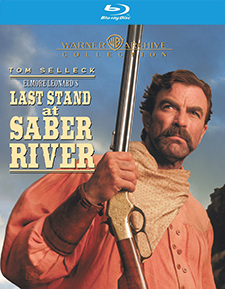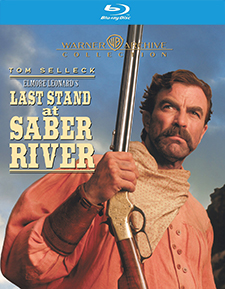Last Stand at Saber River (Blu-ray Review)

Director
Dick LowryRelease Date(s)
1997 (January 28, 2025)Studio(s)
TWS Productions II/Turner Network Television (Warner Archive Collection)- Film/Program Grade: B-
- Video Grade: B+
- Audio Grade: A
- Extras Grade: D-
Review
Made-for-TV movies had their heyday in the 1970s, well before HBO and, later, video dominated home entertainment, but the genre continued in limited form in subsequent decades. Last Stand at Saber River is an ambitious made-for-TV Western, with themes of marital responsibility, loyalty, and vengeance.
In 1865, Southern soldier Paul Cable (Tom Selleck, TV’s Magnum, P.I.) abandons the Confederate army in Texas before the war has ended and heads for his father-in-law’s home in El Paso, where his schoolteacher wife Martha (Suzy Amis, The Usual Suspects) and children Rachel Duncan (What Women Want) and Haley Joel Osment, The Sixth Sense) have been living during the three years of his absence. Their reunion isn’t exactly smooth. Martha believed he had been killed in the war. Their youngest child died of influenza while he was away. Now that he’s back, she wants to return to their home in Arizona.
On the family’s arrival, they find that former Union soldier Duane Kidston (David Carradine, Bound for Glory), his son Vern (Keith Carradine, Cowboys & Aliens) and daughter Lorraine (Tracey Needham, Sensation), and their ranch hands now occupy the property. The Kidstons warn Cable to back off, but Cable stands his ground and kills two of Kidston’s men in a gunfight.
Trading post proprietor Edward Janroe (David Dukes, Without a Trace) has his own grudge against Cable. A former Confederate soldier, he resents that Cable abandoned the cause before the war’s end. Janroe’s misguided patriotism leads to a lethal misunderstanding and a gunfight between Cable and the Kidstons.
Selleck plays Cable as a combination of Gary Cooper and John Wayne. Like Cooper, he isn’t a man of many words, yet projects a “don’t mess with me” manner. Like Wayne, he conveys that he’s not easily intimidated and will stand up for what he feels is right. As Cable, Selleck looks war-weary and somewhat disoriented at his return to civilian life, his face reflecting that he has seen terrible things in battle and now wants only the peace and comfort of family. He recognizes that the relationship he and wife Martha had before he went off to war cannot be the same. What initially appears to be a somnambulistic performance turns out to be Cable’s personality—strong, intimidating, outwardly unemotional.
Amis plays Martha as a tough frontierswoman who has experienced her own hardships and the tragedy of losing a young child. Both she and her husband are damaged emotionally. She’s resentful that he left his family to fight. We believe she can and will shoot straight if necessary, so the two occasions when she saves her husband’s life don’t seem far fetched.
Based on a book by Elmore Leonard, the teleplay by Ronald M. Cohen is fairly conventional, with textbook bad guys, duplicitous characters, vigilante justice, and a West where justice is decided not necessarily by right but by firepower. Some impressive scenes of a horse stampede add stature to the TV movie and give it the look of a feature Western, and the action sequences are staged excitingly by director Dick Lowery. If the film seems familiar, it’s because the plots and characters, in slightly different forms, have been seen in Westerns for years. Last Stand at Saber River isn’t bad; it’s just not terribly original.
Last Stand at Saber River was shot by director of photography Rick Waite on 35 mm film with Panavision cameras and lenses, finished photochemically, and presented in the aspect ratio of 1.33:1. On the Blu-ray, images lack sharpness and appear somewhat soft in a number of scenes. Helicopter shots of a horse stampede and long shots of the Cable ranch showcase the wide open landscape. Color palette tends to favor earthy tones and, despite the gunfights, there isn’t much blood shown. Details, such as Selleck’s long mustache and facial stubble, simple furnishings in the Cable cabin, trees and shrubbery, and the hats worn by the male characters are nicely delineated.
The soundtrack is English 2.0 DTS-HD Master Audio. English SDH subtitles are an option. Dialogue is clear and unobscured by ambient noise. Horses galloping, gun shots, bodies being pummeled, a covered wagon rumbling over rough terrain, a runaway supply wagon, and a home being wrecked are among the sound effects. David Shire’s score is most effective in the scenes involving scope, when his music provides a sense of grandeur. In more intimate scenes, it’s simply background filler.
The only bonus material on the Blu-ray release from the Warner Archive Collection is the following:
- Trailer (1:31)
Last Stand at Saber River is a mediocre Western made on a limited budget, so the cast is fairly small and lacks star power. Known mostly for TV work, Selleck is serviceable in the starring role, never reaching the level of mythic Western hero. Suzy Amis is very good as spirited homesteader Martha, and the Carradines provide a palpable sense of menace. The story is predictable and director Dick Lowery, hampered by an unimaginative script, fails to elevate the picture into anything more than a routine TV movie capitalizing on the popularity of the Western.
- Dennis Seuling

